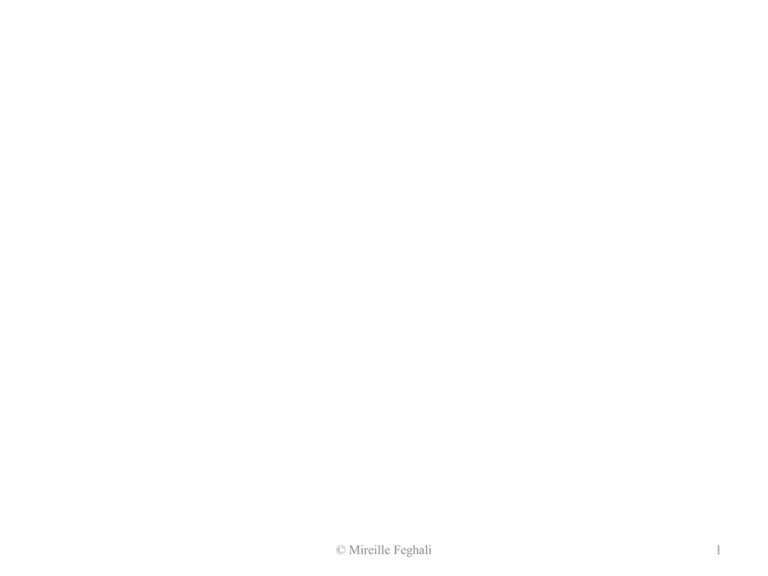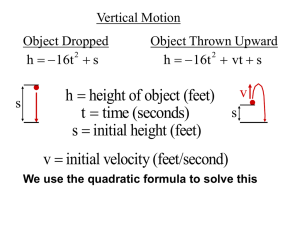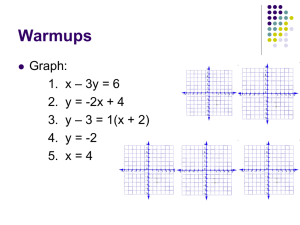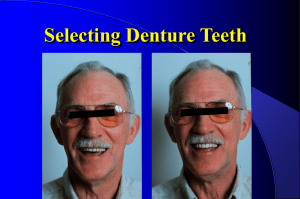1-6. Baratieri LN et al, Composite restorations in
advertisement

© Mireille Feghali 1 Shade selection in complex esthetic restorations with composite Mireille Feghali Fares Département de Dentisterie Restauratrice et Esthétique Université Libanaise mireillefeghali@hotmail.com Formation Continue LDA 2013 © Mireille Feghali 2 Buts • Quesque l’adhésion? • Quels sont les différents adhésifs présents? • Quelle est la meilleure technique? © Mireille Feghali 3 Outline 1- Introduction 2- Cleaning Phase 3- Segmentation Phase 4- Identification Phase 5- Conclusions and Perspectives © Mireille Feghali 4 Plan 1) 2) 3) 4) INTRODUCTION 2.1. Basics of color 2.2. Munsell’s classification 2.3. Translucency and opacity 3.1. Anatomy of natural teeth NATURAL TEETH 2.4. Color contrast and metamerism 3.2. Optical properties of human teeth COLOR 3.3. Color range of natural teeth RESIN COMPOSITES: TYPES AND AVAILABLE SHADES OF RESIN COMPOSITES 5) SHADE SELECTION 6) 5.1. Shade guides 5.2. Thickness of the material 5.3. Type of tissue to restore FACTRORS THAT AFFECT THE COLOR OF THE RESTORATION 7) CONCLUSION 6.1. Color stability 6.2. Aging 6.3. Staining 6.4. The effect of polishing Introduction Creating a lifelike appearance in a restoration is certainly one of the most complex, challenging, and controversial tasks in dentistry. Direct resin restorations require a thorough knowledge of the resin system(s) being used and clinical proficiency in layered placement. However, when skillfully manipulated, these materials can be virtually indistinguishable from the natural tooth substance. Paravina (RD.), Evaluation of a newly developed visual shade-matching apparatus, Int J Prosthodont, 2002; (15), 528. 2) Color 2.1. Basics of color The color of an object is not contained within the object. The color is the result of the light which strikes the object and is reflected by it. ComPadre, The physics classroom, Color and Vision; 2011 Baratieri (LN.) et al, Composite restorations in anterior teeth, fundamentals and possibilities, 2005; Quintessence Books 2) Color 2.1.) Basics of color Nature of incident light Assessment of the observer Physical properties of the object Assessment of the observer O’Brien. (W.) , Dental material and their selection, Quintessence Books, Fourth edition, 2008; p 25-80. 2) Color 2.2. Munsell’s classification Quality of an object: by measurement of hue, chroma and value Sproull (R.), Classical article -color matching in dentistry - part I- The three dimensional nature of color – J Prosthet Dent 2001; (86), 453-457. 2) Color 2.2. Munsell’s classification: Hue Baratieri (LN.) et al, Composite restorations in anterior teeth, fundamentals and possibilities, 2005; Quintessence Books 2) Color 2.2. Munsell’s classification: Chroma The intensity or saturation of a hue Low Chroma High Chroma Sproull (R.)- Classical article- color matching in dentistry – part I- the three dimensional nature of color – J Prosthet Dent 2001; (86), 453-457. 2) Color 2.2. Munsell’s classification: Value The relative darkness or lightness of a color, or brightness of an object Low value High value Sproull (R.)- Classical article- color matching in dentistry – part I- the three dimensional nature of color – J Prosthet Dent 2001; 86, 453-457. 2) Color 2.2. Munsell’s classification Quality of an object: by measurement of hue, chroma and value Sproull (R.), Classical article -color matching in dentistry - part I- The three dimensional nature of color – J Prosthet Dent 2001; (86), 453-457. 2) Color 2.3. Translucency and opacity Baratieri (LN.) et al, Composite restorations in anterior teeth, fundamentals and possibilities, 2005; Quintessence Books. 2) Color 2.4. Color contrast and metamerism Color contrast: The notion of color contrast is essential to a modern understanding of color perception. The yellow band on the right appears darker and yet both are identical. This Is due to the effect of absorption of the yellow color by the surrounding red B3 appears identical to A3.5 simply because of the absorption of color by the proximity of the gum. TOLILA (Y.); Comment transmettre la bonne « teinte » grâce à la photo et la colorimétrie numériques?, 2004; 7. 2) Color 2.3. Color contrast and metamerism Sometimes colors may appear to be the same, even when they are composed of different spectral transmission curves. However, when illumination is changed, that apparent match is lost. Colors which appear to be the same in a given illumination but which are evolved by different spectral curves are said to be metamers. Light source # 1 Light source # 2 Light source # 3 Irfan Ahmad ; Three-Dimensional shade analysis: perspectives of color-part II; Pract Periodont Aesthet Dent 2000; 12(6): 557-564. Sproull (R.), Preston (JD.), Understanding color in Goldstein RE, Esthetics in dentistry, 1998; (2). 3) Natural teeth 3.1. Anatomy of natural teeth Anatomy and histology of the dental tissues The effect of these tissues on light Optical properties of teeth Bosch Ten (JJ.), Coops (JC.),Tooth color reflectance as related to light scattering and enamel hardness, J Dent Res, 1995; (74), 374. 3) Natural teeth 3.1. Anatomy of natural teeth1 . Vertical ridges 2. Vertical grooves 3. Horizontal ridges 4. Horizontal grooves 5. Perikymata 6. Enamel pits and vertical irregularities Baratieri (LN.) et al, Composite restorations in anterior teeth, fundamentals and possibilities, 2005. 3) Natural teeth 3.2. Optical properties of human teeth Enamel is very translucent and might transmit up to 70% of light through a section that is 1 mm thick. Dentin is less translucent than enamel and can transmit up to 30% of light through a 1 mm thick section. Raptis (N.), Optical Behavior of Current Ceramic Systems, The International Journal of Periodontics & Restorative Dentistry, Dent Technol, (26), 2006; 31. 3) Natural teeth 3.3. Color range of natural teeth Differences in tooth color exist within the same tooth. Central incisors had the highest lightness. Women’s teeth in general were lighter and less chromatic, than men’s. Tooth color was best represented by its middle third. Aging produced darker and more reddish teeth. Baratieri (LN .)et al, Composite restorations in anterior teeth, fundamentals and possibilities, 2005, Quintessence Books Vaarkamp (J .)et al, Propagation of light through human dental enamel and dentine, Caries Res, 1995; (8), 29. 4) Resin composites:Types and available shades of resin composites Resin composites acceptable alternative to amalgam. To achieve the best esthetics, resin composite restorations must match natural teeth in appearance and must maintain that appearance over time. O’Brien. (W.) , Dental material and their selection, Fourth edition, 2008; Quintessence Books, p 25-80 4) Resin composites:Types and available shades of resin composites Shades Sizes and shapes. Natural teeth Opacities Textures O’Brien. (W.) , Dental material and their selection, Fourth edition, 2008; Quintessence Books, p 25-80 4) Resin composites:Types and available shades of resin composites Resin composites are classified by use (anterior, flowable, laboratory, packable, posterior, universal) or by type of filler particle (microhybrid, microfill, nanofill). Composites are also designated by shades: universal shades, bleaching shades, and highly esthetic (layered) shades. O’Brien. (W.) , Dental material and their selection, Fourth edition, 2008, Quintessence Books, p 25-80 4) Resin composites:Types and available shades of resin composites MICROFILLED MICROHYBRID NANOFILLED Filler size 0.01-0.12μm 0.01-3 μm 0.005-0.1μm Appearance Optical properties similar to enamel Good gloss, luster and smoothness Good gloss, luster and smoothness Polishability Highly polishable Polishable Highly polishable Usage Non-stress bearing esthetic restorations Anterior and posterior restorations Very high aesthetic properties (anterior restorations) O’Brien. (W. ), Dental material and their selection, Fourth edition, 2008, Quintessence Books, p 25-80 Beuna (S.), Glorieux (T.), Characterization of nanofilled compared to universal and microfilled composites, dental materials, ELSEVIER, 2006; 1-9. 4) Resin composites:Types and available shades of resin composites Close to 80% of dentists prefer to execute monochromatic restorations, since they are much easier, faster and less stressful than polychromatic restorations. Unhappily, however, these are not always acceptable. Baratieri (LN .)et al, Composite restorations in anterior teeth, fundamentals and possibilities, 2005, Quintessence Books 5) Shade selection Several clinical studies confirm that computer-assisted (spectrophotometer, digital camera..) shade analysis is more accurate and more consistent compared to human shade selection [ Paul et al, in 2002] Yilmaz (B.), Karaagaclioglu (L.), Comparison of visual shade determination and an intra-oral dental colorimeter, Journal of Oral Rehabilitation, 2008; (35), 789-794 5) Shade selection 5.1. Shade guides An adequate shade matching method is of the highest importance in esthetic dentistry. The selection of a shade the appointment period. The most important part of PARAVINA (R D.), New Shade Guide for Evaluation of Tooth Whitening-Colorimetric Study , Blackwell munksgaard, J Esthet Restor Dent , 2007;(19), 276–283. 5) Shade selection 5.1. Shade guides PARAVINA (R D.), New Shade Guide for Evaluation of Tooth Whitening-Colorimetric Study , Blackwell munksgaard, J Esthet Restor Dent , 2007;(19), 276–283. 5) Shade selection 5.2. Thickness of the material To obtain high quality in aesthetic dentistry Layer thickness of the composite Texture Translucency and opacity Vichi (A.), Fraioli (A.), Influence of thickness on color in multi-layering technique, Dental Materials, 2007; 1-6. 5) Shade selection 5.2. Thickness of the material Any mistake during application of resin composite may lead to an excessively translucent or opaque restoration, because a single shade may present different grades of translucency and opacity depending on the thickness of the resin composite layer applied. Vichi (A.), Fraioli (A.), Influence of thickness on color in multi-layering technique, Dental Materials, 2007; 1-6. Baratieri LN et al, Composite restorations in anterior teeth, fundamentals and possibilities, 2005, Quintessence Books 5) Shade selection 5.2. Thickness of the material The greater the opacity The less the translucency The greater the thickness Vichi (A.), Fraioli (A.), Influence of thickness on color in multi-layering technique, Dental Materials, 2007; 1-6. Baratieri LN et al, Composite restorations in anterior teeth, fundamentals and possibilities, 2005, Quintessence Books 5) Shade selection 5.3. Type of tissue to restore Dietschi (D.), A new shading concept based on natural tooth color applied to direct composite restorations; Quintessence International, 2006; (37), 92. 5) Shade selection 5.3. Type of tissue to restore Natural humidity of the oral cavity Clean tooth Rubber dam Koubi S., A. Faucher, Restaurations antérieures directes en résine composite : des méthodes classiques à la stratification, EMC, Elsevier, Odontologie, 2005;(23), 136. 5) Shade selection 5.3. Type of tissue to restore Baratieri LN et al, Composite restorations in anterior teeth, fundamentals and possibilities, 2005, Quintessence Books 5) Shade selection 5.3. Type of tissue to restore Baratieri LN et al, Composite restorations in anterior teeth, fundamentals and possibilities, 2005, Quintessence Books 5) Shade selection 5.3. Type of tissue to restore Schematic drawing of the tooth, showing details of the shade and surface texture: THE KEY TO OBTAIN A SUCCESSFUL RESTORATION Baratieri LN et al, Composite restorations in anterior teeth, fundamentals and possibilities, 2005, Quintessence Books 5) Shade selection 5.3. Type of tissue to restore The lingual aspect of teeth Application of translucent resin to reproduce the palatal portion of the tooth. Note the translucency achieved by the resin composite. Baratieri LN et al, Composite restorations in anterior teeth, fundamentals and possibilities, 2005, Quintessence Books 5) Shade selection 5.3. Type of tissue to restore Shade A3 for dentin of the restorative material system-specific shade guide was applied at the internal region because of the more opaque characteristic. Baratieri LN et al, Composite restorations in anterior teeth, fundamentals and possibilities, 2005, Quintessence Books 5) Shade selection 5.3. Type of tissue to restore Reproduction of dentinal mamelons: more superficial and thus less opaque dentin This reduction in hue at this step is important for achievement of a natural-looking restoration. Baratieri LN et al, Composite restorations in anterior teeth, fundamentals and possibilities, 2005, Quintessence Books 5) Shade selection 5.3. Type of tissue to restore Translucent resin applied at regions with greater incisal translucency. After this stage, the existing space should correspond to the enamel thickness. A2E shade was applied over the other shades, reproducing the buccal enamel. Baratieri LN et al, Composite restorations in anterior teeth, fundamentals and possibilities, 2005, Quintessence Books 5) Shade selection 5.3. Type of tissue to restore Baratieri LN et al, Composite restorations in anterior teeth, fundamentals and possibilities, 2005, Quintessence Books • The dentist’s eyes should be on the level of the patient’s tooth. Regarding shade matching distance, visual acuity for near vision is tested in ophthalmology at the standard reading distance of 25 or 33 cm; the suggested minimum standard of visual acuity for dental practitioners is 6/7.5 at 33 cm. Based on all these facts, a working distance of 25 to 33 cm appears to be acceptable for everyone. The shade tab should be placed parallel with the tooth whose shade is being matched, and with the same relative edge position. lf possible, it should be in the same plane with the tooth, not in front of it, or it will appear lighter; and not behind it, or it will appear darker. The tab carrier, especially if metal, should be put along its normal axis to avoid possible impact on the tab color, especially in the incisal/occlusal region, where teeth are the most translucent • The first impression is frequently the best match, and shade matching trials should be limited to 5 seconds at a time to prevent eye fatigue. The vision pigment is used up quickly in the mechanism of color perception. (Fortunately, it is regenerated continuously and almost instantaneously). The recommendation to relax the eyes by observing a blue card between two shade matching trials (because blue and yellow are complementary colors) has been given many times in dental literature. It was explained that this would cause blue fatigue and increase the eye sensitivity to differentiate yellow color (predominant tooth color). 6) Factors that affect the color of the restoration 6.1. Color stability Color instability: The major disadvantage of resin composites, which may be a major cause for replacement of restorations. Dimensions of filler particles Depth of polymerization Resin matrix Coloring agents Pires de Souza (F.), Color Stability of Composites Subjected to Accelerated Aging after Curing Using Either a Halogen or a Light Emitting Diode Source; Color stability of composites; Braz Dent J ,2007; (2),119-123. 6) Factors that affect the color of the restoration 6.2. Aging Stefano (A.) et al; A long-term laboratory test on staining susceptibility of esthetic composite resin materials; Quintessence International, 2010; (41), 695-702. 6) Factors that affect the color of the restoration 6.3. Staining Incomplete polymerization Smoothness of the restoration. Staining Chemical reactivity Diet, oral hygiene Iffat (N.), Prasanna (N.) et al, Color stability of microfilled, microhybrid and nanocomposite Resins -An in vitro study, journal of dentistry , 2010; e 137 – e1 42. 6) Factors that affect the color of the restoration 6.4. Effect of polishing Esthetics and longevity of resin composite restorations Watanabe (T.), Influence of polishing instruments on the surface texture of resin composites, Quintessence International, 2006; (37), 61-67 7) Conclusion Are the restorations with composites similar to natural tooth possible? YES Principal characteristics Because of these difficulties of anterior teeth and the improvements offered by other restorative systems such as indirect restorations: Aren’t they gaining favor in the field of Technique for the dentistry? esthetic restorative selection of the shade Having materials available









